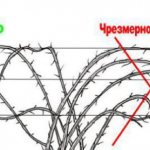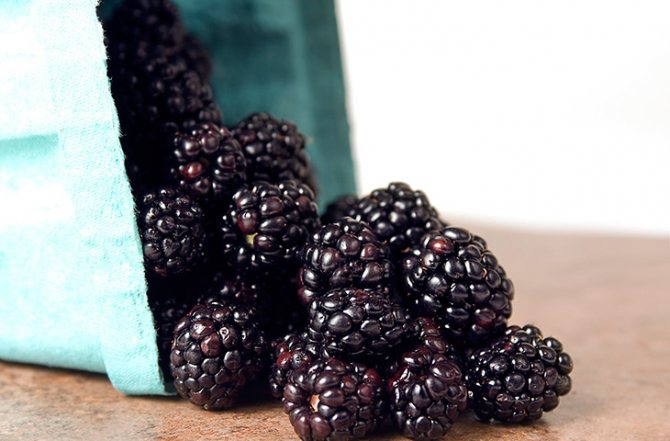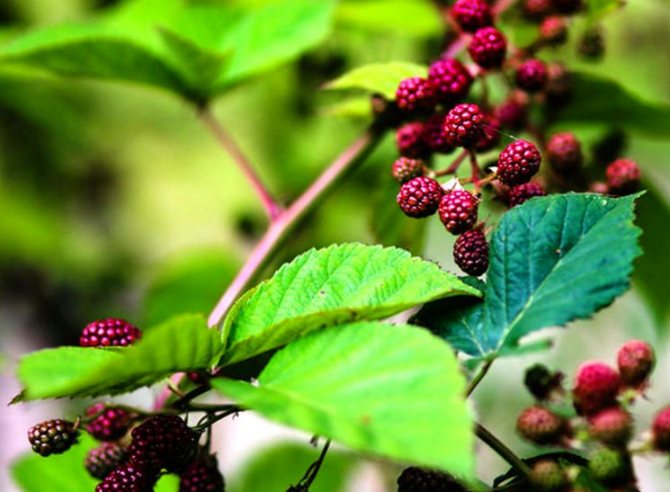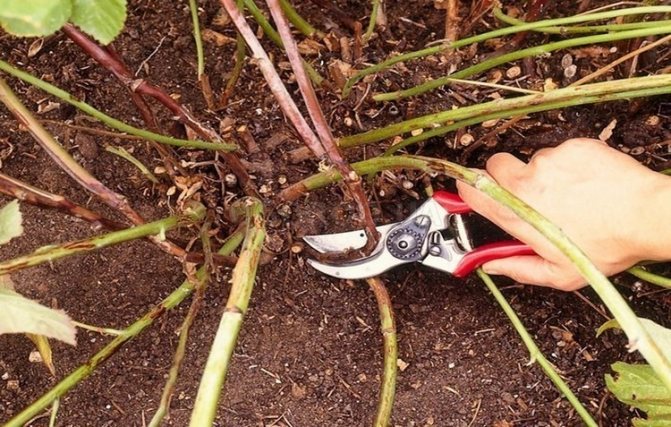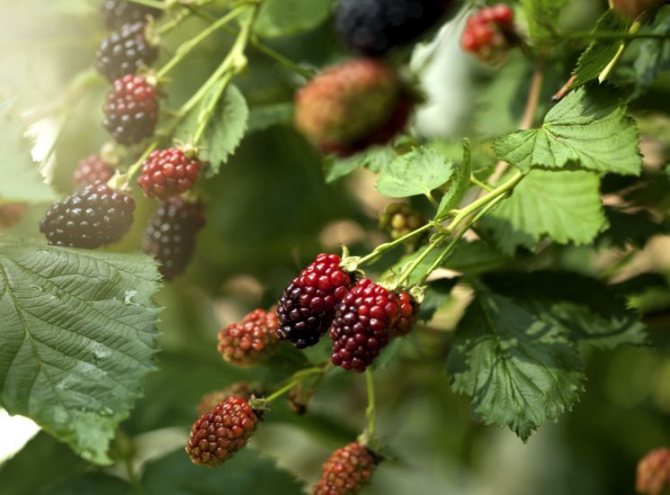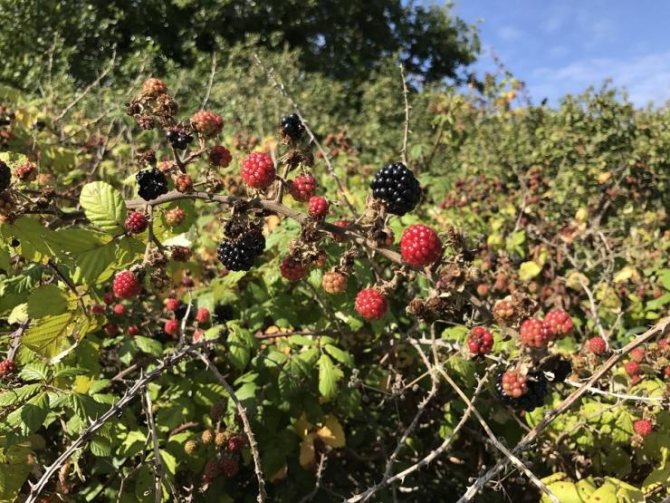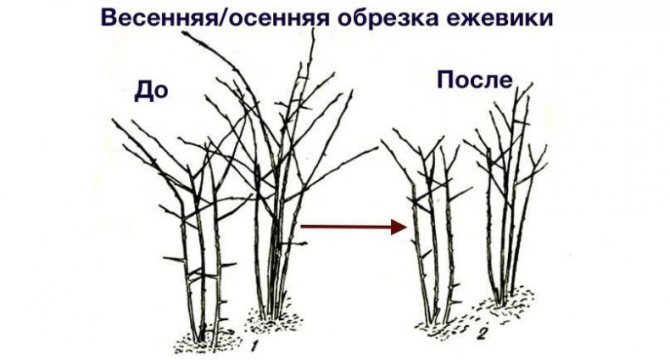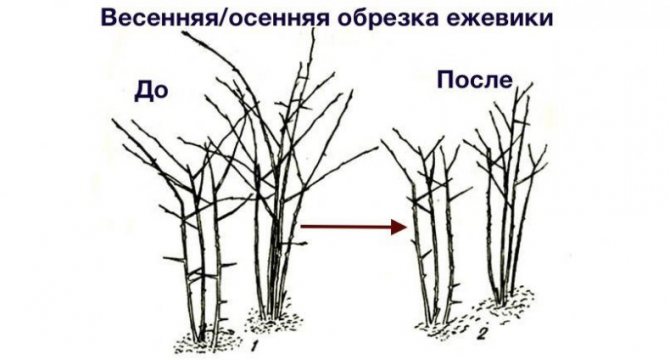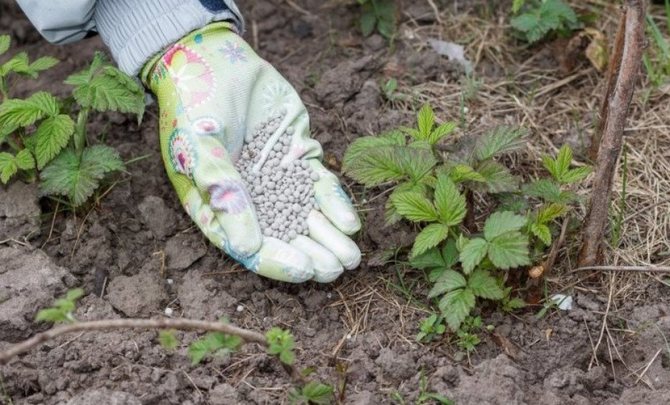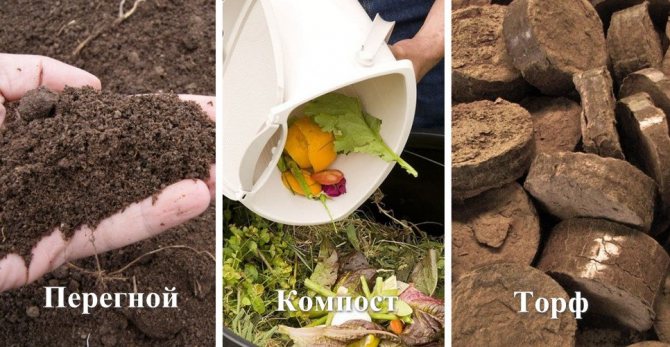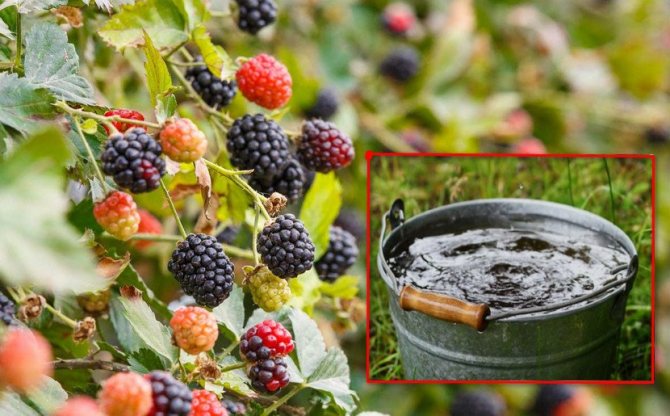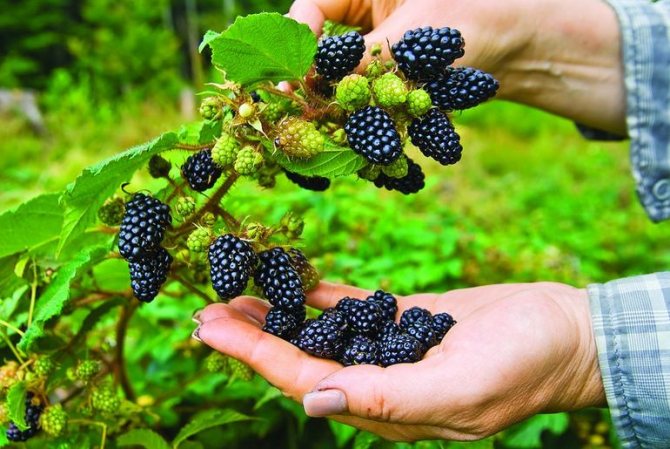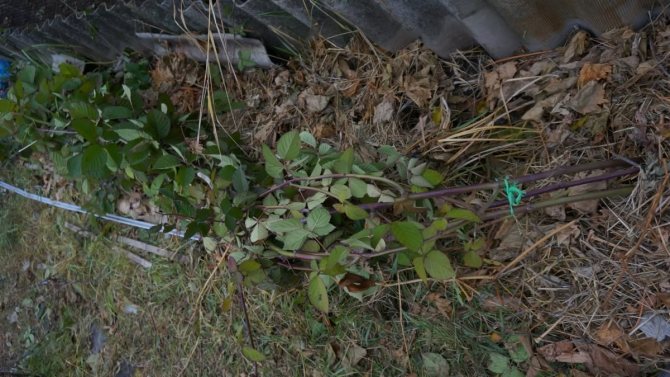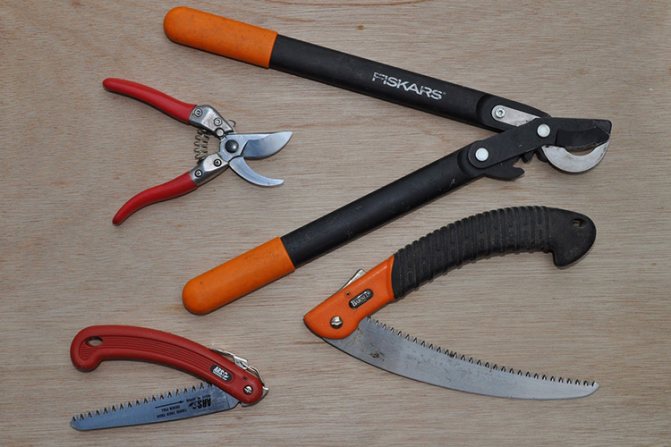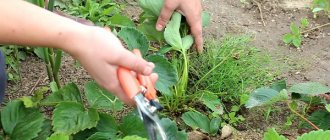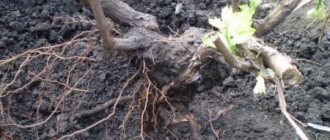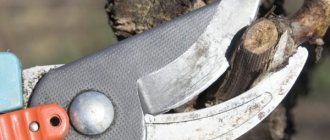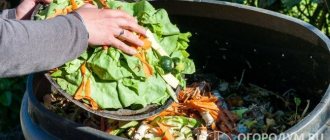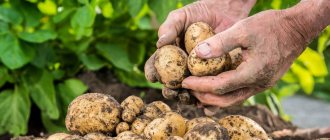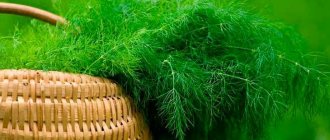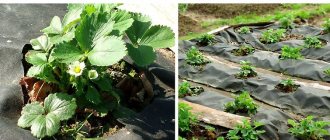What is the autumn pruning of blackberries for?
To prepare the blackberry for winter, you need to rid the plant of excess green mass.
Competent pruning will allow the bush:
- Rationally use nutrients between branches that will bear fruit next season and will not feed useless old stems.
- Do not freeze out in winter.
- Increase immunity to fungal diseases in the off-season.
- It is more active to form buds of growth and flowering, large berries.
- Get a lot of sunlight for the growth of shoots, ripening of fruits, as the shading of young and fruiting lashes will decrease.

Blackberry bush formation
The need for a procedure
A beginner's guide to pruning blackberries in the fall should probably start by explaining the reasons that do this. procedure necessary for caring for fruit-bearing bushes... This shrub is a plant with a two-year fruiting cycle, that is, the shoots grow and develop for one year, and in the second they become woody, covered with flowers and produce a harvest of sweet berries. In the third year, they will no longer bear fruit, so they are pruned.
How to store gladioli in winter at home
If this is not done, then the bushes will thicken, which is why the young branches will not ripen. Excessive bushiness will shield the fruits from the sun, making them small and sour.
Blackberry processing is needed to solve the following tasks:
- Protection from pests and diseases.
- Old branches obscure young shoots from the sun's rays, which reduces the frost resistance of the plant.
- Large bushes are difficult to cover for the winter.
- Pruning young twigs stimulates them to bloom next summer.
- Nutrients are not wasted on old, unnecessary branches and go to the development and growth of fruitful shoots.
- Pruning helps to strengthen the plant and helps to improve the quality and quantity of the crop.
If you adhere to the correct system of forming bushes, then you can minimize all the inconveniences that this berry culture can bring. As a result of active and fruitful work, breeders were able to obtain thornless varieties of blackberries, their pruning is even easier than that of thorny bushes.
Knowing these subtleties, the novice gardener will not doubt whether it is necessary to prune the blackberries for the winter.
How to properly prune blackberries
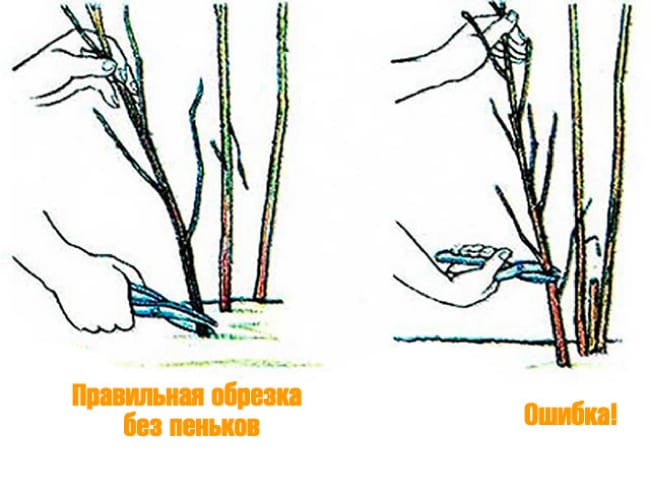

Correct pruning of blackberries
Autumn pruning of thornless blackberries is different: all branches are shortened to a height of 4 buds from the ground. This variety is also two years old, but not root, but lateral shoots bear fruit. The rest of the crop is cut according to the following algorithm:
- Cut off dead wood, branches damaged by pests and weak, thin growth that will not withstand frost.
- The branches from which the crop was harvested are removed by cutting them at the root.
- 8-10 strong stems are left in each bush. The plant is capable of providing nutrients to 6–7 productive lashes. It is necessary to leave an extra 2-3 stems for the bush to survive if it is damaged by frost or disease.
- To activate the formation of peduncles, the tops of the left vine are trimmed by ¼ of the length (5 mm higher than a healthy bud).
- All sections are processed with a solution of potassium permanganate (0.5 g per 100 ml of water).
- Cut off branches, fallen leaves are removed from the berry, burned.
Culture care
Caring for fruiting bushes in the middle of autumn helps the plant to get stronger, preserve as many shoots as possible for the next season and lay fruit buds on young shoots.


Blackberry care in autumn:
- pruning;
- top dressing;
- shelter.
Pruning rules
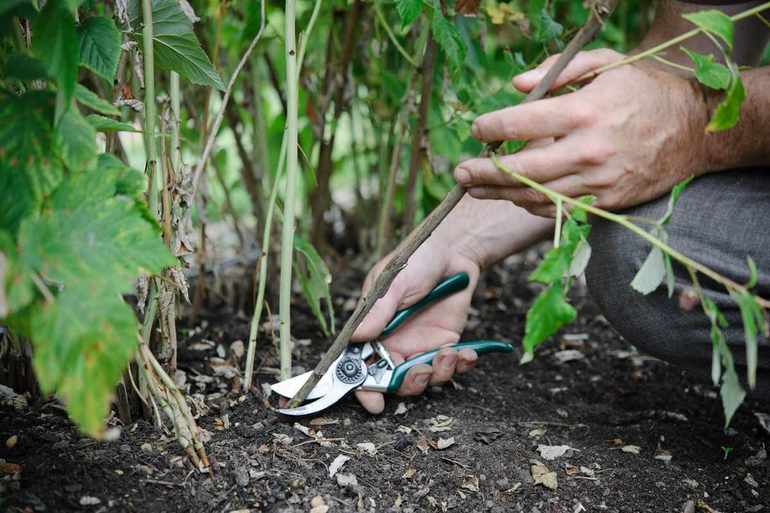

The scheme and complexity of the work depends on the age of the branches, variety and type of culture. Upright bushes form a large number of shoots from the underground part. Trimming the top encourages the growth of lateral stems, which will tie flower buds and ripen the fruit.
Creeping strongly branching species do not form root shoots, but form numerous lateral fruit shoots. During the summer period, vines more than 10 m long are densely intertwined, making it difficult to care for the plant.
Before pruning, the plant is examined, the condition of the shoots is determined. Healthy lashes are brown, shiny, bend easily, do not break. At the stage of bush formation, the intertwined stems are separated, the fruiting branches are separated from the young ones. Creeping varieties are removed from the trellis and laid on the ground. 5-10 strong shoots are left for the winter. They are marked with cloth tape to avoid accidentally cutting them off.
How to properly prune blackberries for the winter:
- With the help of a pruner, the branches that have borne fruit are completely removed. They are cut at the root, leaving no tips on the surface of the soil.
- Broken young twigs, thin, too short, damaged and diseased shoots are pruned.
- In remontant varieties, all branches are cut below ground level.
- For the formation of lateral shoots, annual stems are pinched immediately above the bud, straight varieties at a height of 2 m, creeping - 3 m.
- When thinning bushes of straight-growing varieties, 4-7 strong shoots are left and 8-10 on creeping species. The distance between the shoots should be 8-10 cm.
- Ripe young stems are cut into на part, collected in a bunch, fixed on the ground or on a low support.
- Stems that will winter without shelter are shortened to the same height - from 1.5 to 1.8 m.
Pre-winter watering and feeding
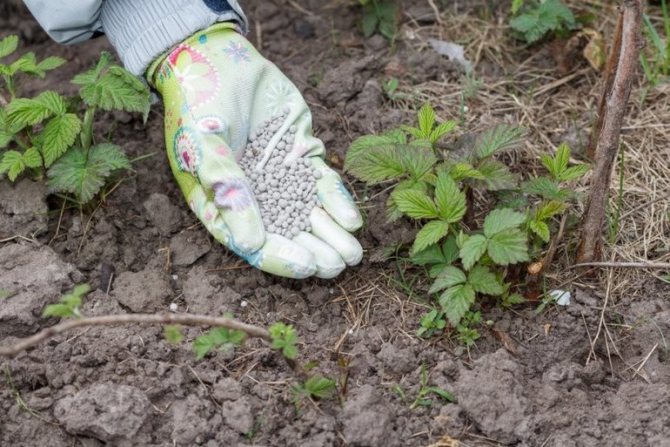

After removing the shoots, the blackberries are fed with potash and phosphorus fertilizers. Compost with the addition of superphosphate is dug under each bush. Carefully dig the soil under the thornless blackberry bushes. If the root system is damaged, some varieties may develop spiny offshoots.
Important!
Do not use nitrogen. Nitrogen fertilizing stimulates the growth of shoots, which is undesirable in the pre-winter period.
If the autumn is warm and without rain, the blackberries are watered abundantly before the shelter. At least 20 liters of water are poured under each bush. The soil will retain high humidity, the root system will continue to grow and the plant will not weaken by winter.
To protect the blackberry bush from pests hiding in the soil for the winter, copper sulfate or 3% hydrogen peroxide solution is used. The aerial part of the plant is sprayed with a liquid, the soil is disinfected. For blackberry roots, peroxide serves as a useful fertilizer, enriching them with oxygen.
Bush shelter
Cultivated varieties are less resistant to severe frosts than shrubs in the forest. Blackberries, grown and brought from the northern regions, tolerate the winter well. Creeping species can withstand temperatures as low as -16 ° C, upright species - down to -20 ° C. Before the shelter, fallen leaves are raked up from under the bushes, the beds are mulched with dry humus. Blackberry stems are bent to the ground, laid in a trench on a prepared bedding, fixed with hooks to the soil or metal arcs. The litter is laid out from needles, grass cuttings, thin branches, bark.
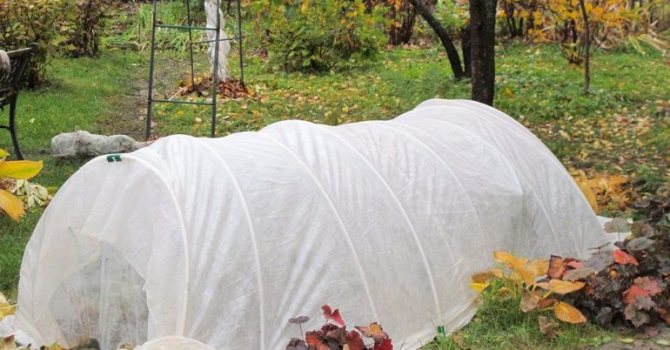

Creeping species easily bend and fold into a circle, and upright branches do not lend themselves to sharp bends and can be broken. In order not to damage the plant, after pruning, a load is fixed at the tops of the stems. Under the weight, the branches will gradually tilt and lie on the ground.They are tied with twine, treated with copper sulfate, and pressed with boards from above.
For the upper shelter, agrofibre or organic insulation (corn, straw, wood chips, reeds, leaves, grass) is used. Film as the main cover is not suitable. It is spread with an additional top layer on an insulating material to protect it from moisture. Organic insulation retains heat well, but in spring, rotten and damp plants are difficult to remove from thorny bushes.
In winter, wet foliage attracts rodents, which harm the young stems of the blackberry. To do this, a seed from pests is placed in the middle of the bush. Insulation made from pine needles, spruce and pine branches prevents pests from starting. Lapnik is laid on the plant together with a film or agrofibre.
Besshorny varieties are covered with green manure, for the winter - with peat and 4-5 layers of dense spunbond. The non-woven fabric is dropped or pressed with long boards.
The future harvest depends on the autumn work in the garden. Timely care of blackberries and control of shoot growth allows next year to collect from 1.2 to 1.6 kg of tasty and medicinal berries from each bush.
Bush formation scheme
The correct formation of the blackberry bush in the spring affects the autumn pruning. Crown molding methods:
- Fan-shaped. Shoots are divided into 2 parts - vegetative and fruiting. The long stems on which the berries will form are tied vertically to the trellis. Short ones - spread apart, fixed at a height of 30-50 cm.
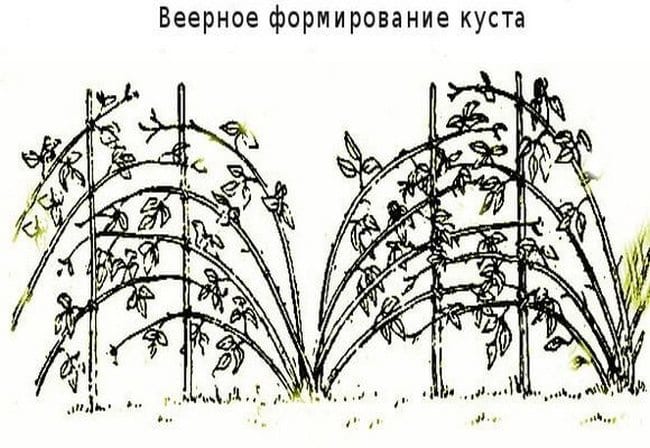

Fan formation of a blackberry bush
- Cable. The stems collected in a bundle are tied with rings at different heights so that the bush is inside the "cylinder". The lashes are evenly distributed so that they do not obscure each other. The structure is attached to the support.


Rope way of forming a blackberry bush
- Wicker. Before fastening to the trellis, the stems are divided into 2 bundles and twisted together. This crown formation provides stability to the bush.


Erect varieties
For fastening upright varieties of culture, a trellis with a height of at least 1.8 m is required. Rows of wire are placed horizontally at a distance of 30-50 cm from each other. The branches that will bear fruit in the current season are carefully tied to the structure in an upright position, trying not to damage, and the young growth from the central part of the bush is directed horizontally and, as it develops, is tied up. In the fall, all the stems of the central part are cut off.
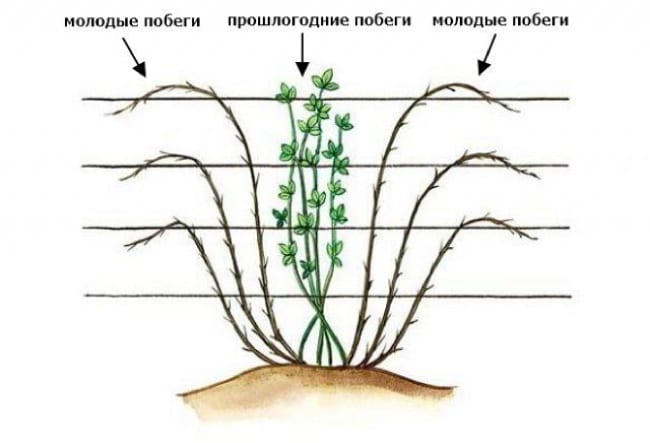

Trellis method of tying blackberries
Creeping varieties
The stems of the creeping blackberry are more flexible. For the formation of bushes, all the shoots are divided into vegetative and fruiting. The first type of stems are fanned to the horizontal supports on the right, and the second - on the left (or vice versa). This method prevents the entanglement of old and new lashes, facilitates the picking of berries and the autumn pruning of branches that have borne fruit.


Pruning creeping blackberries
Repairing blackberry
The remontant blackberry variety differs from other types of culture in that the fruits form young and two-year lashes. Erect shoots are fixed vertically. The main condition for the formation of a bush is not to create shading with intertwining branches. The process of pruning this type of blackberry is the simplest: in the fall, all the stems are cut, leaving short stumps. It will not be difficult for a gardener to cover them before winter.
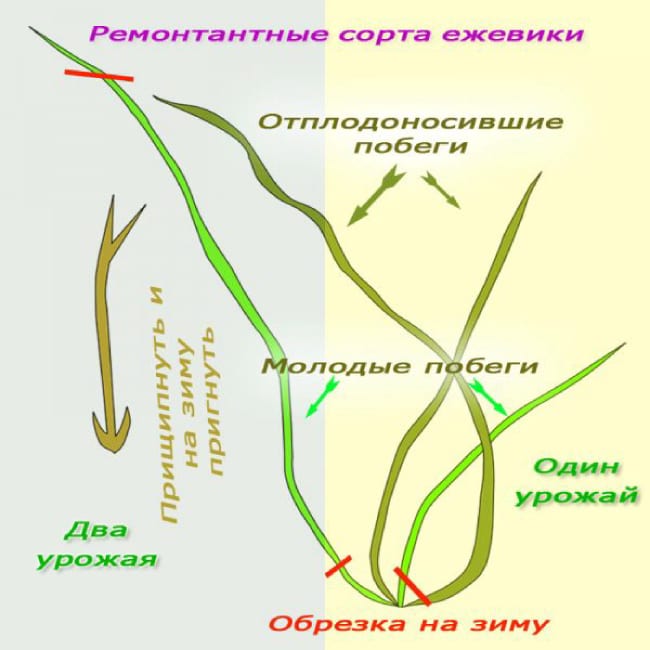

Pruning the remontant blackberry
Plant processing tools


Any gardening procedure requires good tools, especially the processing of such a difficult plant as a blackberry. For pruning, the gardener should get delimber and pruner... Stores offer a wide range of such items. Before grabbing the first specimen that comes across, it is worth finding out if it is suitable for pruning blackberries. Also, when making such purchases, it is important to remember that the tool should last for many years.
Features of processing grapes in the fall before shelter for the winter
The diameter of adult branches is on average about 1.5 centimeters. Any secateurs can handle this thickness. For processing blackberries, you should pay attention to the bypass tool. It works in the same way as regular scissors. When choosing a secateurs you need to pay attention to the gaps between the blades... If a gap is visible there, then the device will chew on the branches, and not carefully cut them off.
The degree of sharpening is also very important. Sharp blades make it easier to carry out such work, they greatly facilitate the process. This point is especially important when choosing a tool for processing thorny plants. In order to simply shorten the shoots, it is better to use an anvil pruner - a flat plate will hold the branch while a sharp knife cuts it off. But when working with it, it is important to hold the tool at one angle, otherwise, instead of cutting it, it will simply break the stem.
For the autumn removal of woody shoots, it is better to use a lopper. This device will help get rid of thick branches and shorten the growth in the middle of the crown, which the pruner cannot cope with. Its long handles make it easy to prune in the center of the bush without touching the sharp thorns.
If neither the pruner nor the lopper could handle the job, only a garden saw will help. It has a special setting angle and a special sharpening of the teeth, which will allow you to cut the shoots in 2 directions. The advantage of such a tool is the ability to leave smooth cuts, which reduces the risk of infection of the bush, and also looks more aesthetically pleasing.
Blackberry short description
The blackberry belongs to the Rosaceae family, the Rubus genus and has more than 200 species in nature. Since time immemorial, people have been eating wonderful berries, which often grew on the outskirts of villages, behind vegetable gardens.
The blackberry was often used as a hedge that neither beast nor man could overcome. And black and gray berries were an indispensable part of the diet of the whole family. The amazing qualities of blackberries are reflected in ancient legends. According to one of them, blackberries are drops of blood of titans who shed it on the ground in a battle with the gods.
The economic value of blackberries is difficult to overestimate. Inflorescences, fruits, leaves, shoots and roots are used as medicinal raw materials. Blackberries contain:
- up to 13% sugars (glucose and fructose);
- up to 1.5% organic acids (malic, citric, acetylsalicylic, tartaric, etc.);
- 1.8% pectin substances;
- up to 4% fiber;
- vitamins C, E, groups B and P;
- carotene;
- tannins;
- pigments;
- salts of potassium, manganese, copper, calcium, phosphorus, iron, etc.
The rich biochemical composition determines the unique healing properties - the blackberry is a real pharmacy for the human body. In addition, blackberries contain adsorbents that remove toxins from the human body. Moreover, the adsorbents are preserved during processing, which significantly increases the nutritional value of berries.
The yield of blackberries and their hybrids is 3-4 times higher than that of raspberries. Blackberries surpass raspberries in terms of the content of biologically active substances, they have more organic acids, P-active substances, a wide range of trace elements.
Blackberries are denser, so they are not damaged during harvesting, they are easily separated from the cup along with the fruit, they are perfectly transported, practically do not grow moldy and can be stored for a long time in the refrigerator.
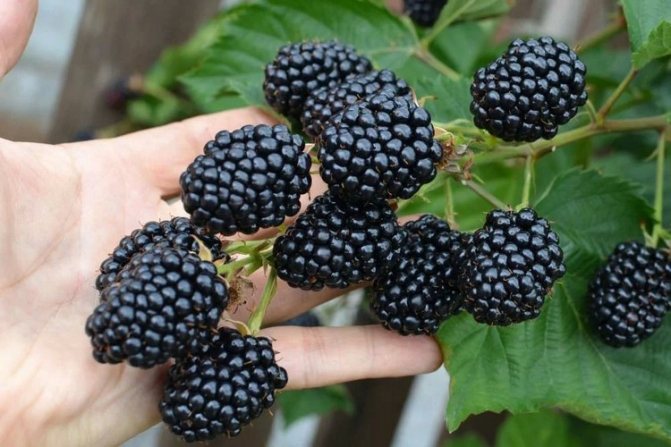

Care after pruning
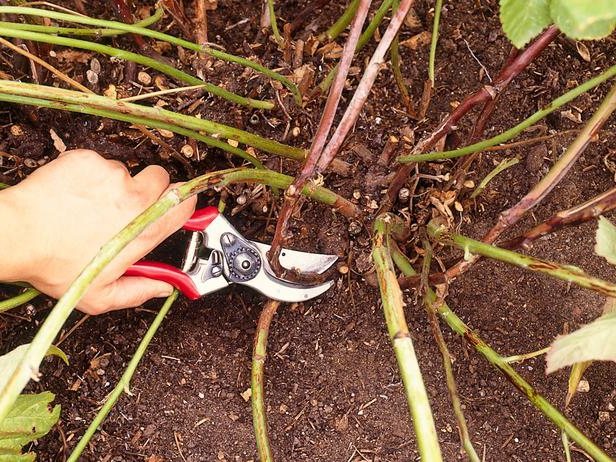

After pruning from under the bushes, you should collect all the debris and branches, and then burn them in order to prevent the possible spread of diseases and pests on the site. So that moisture does not evaporate from the soil, and the roots do not suffer from frost, sprinkle the ground near the shrub with peat or sawdust. It is recommended to cover thermophilic blackberries for the winter.Stressful wintering can lead to poor fruiting or no berries at all.
The stems of the climbing shrub are collected in a bunch and secured with pegs or metal staples. Weights are tied to the shoots of erect varieties in August so that the branches gradually lean closer to the ground. From below, under the branches, before wintering, spruce branches, hay, straw or rotted manure are placed. From above, roofing felt or a thick plastic wrap can be used as a cover.
Timing
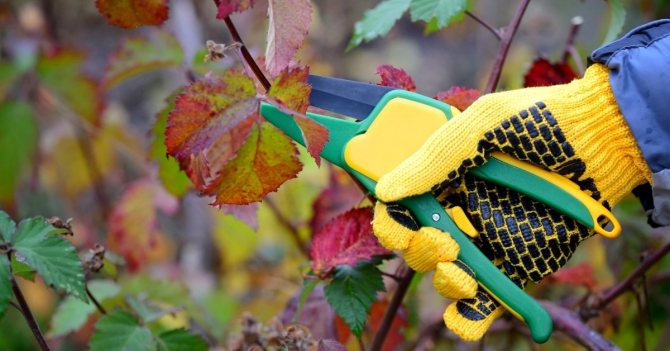

In general, there is no clear answer to the question - when to carry out the autumn pruning of a blackberry bush. In each region, gardeners solve it differently, starting from the realities of the specific climate and the end of the fruiting culture.
In any case, it is necessary to finish the procedure at least 3-4 weeks before the first frost. If you tighten it longer, young shoots may not survive the winter, since they will not have time to get stronger.
On average, pruning can be done from late August to late October. Most gardeners carry out the procedure in September, after the 15th. During this period, the fruiting of berry crops was completed in most regions of Russia.
If we talk about the terms more specifically, then they can be divided as follows:
- in the north of the country, in the Siberian regions and in the Urals, the optimal period is the end of summer;
- in the central part, the Volga region and the Moscow region, pruning is best done in September;
- in the south of the country, work can wait until the end of October.
According to the lunar calendar, autumn pruning of berry and fruit bushes is best done:
- in September - 1-2, 6-7, 15-17 and 27-28;
- in October - 2-5, 12-13, 29-31.

